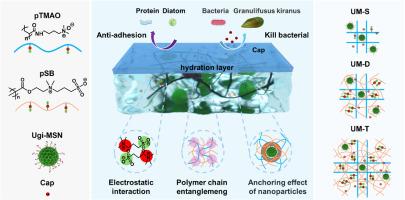Mesoporous silica reinforced triple-network poly-zwitterionic hydrogel with high-strength and excellent anti-fouling performance
IF 9.8
1区 材料科学
Q1 MATERIALS SCIENCE, COMPOSITES
引用次数: 0
Abstract
Zwitterionic hydrogels have garnered considerable attention due to their excellent anti-fouling properties and biocompatibility. However, the application of zwitterionic hydrogels in the seawater is usually limited by excessive swelling and weak mechanical properties caused by the “anti-polyelectrolyte” effect. Moreover, relying on a single anti-fouling mechanism cannot provide long-term protection. In this study, a zwitterionic nanocomposite triple-network hydrogel (UM-T) fabricated through a combination of nanoparticle reinforcement and a multiple network strategy is proposed. This hydrogel exhibits outstanding mechanical strength and exceptional anti-fouling performance. Surface-modified nanoparticles (Ugi-MSNs) served as “anchoring” effect for the molecular chains within the hydrogel enhance network entanglement, while the robust electrostatic interactions within the triple-network structure dissipate energy, thus improving toughness. As a result, the hydrogel demonstrated remarkable mechanical properties in saline environments with a compressive fracture stress of 19.3 MPa, toughness of 2.4 MJ m−3, and modulus of 0.63 MPa. Additionally, capsaicin loaded in Ugi-MSNs enables sustained release of capsaicin for bactericidal effects. The hydrogel effectively resists the attachment of proteins, bacteria, and cells, making it highly effective in marine anti-fouling applications.

介孔二氧化硅增强三网聚两性离子水凝胶,具有高强度和优异的防污性能
两性离子水凝胶因其优异的抗污染性能和生物相容性而受到广泛关注。然而,两性离子水凝胶在海水中的应用通常受到“抗聚电解质”效应导致的过度膨胀和力学性能弱的限制。此外,依靠单一的防污机制不能提供长期的保护。本研究提出了一种结合纳米颗粒增强和多网络策略制备的两性离子纳米复合三网水凝胶(UM-T)。这种水凝胶具有优异的机械强度和优异的防污性能。表面修饰纳米颗粒(Ugi-MSNs)对水凝胶内部的分子链起到“锚定”作用,增强了网络纠缠,而三网结构内部强大的静电相互作用则耗散了能量,从而提高了韧性。结果表明,该水凝胶在盐水环境中表现出优异的力学性能,压缩断裂应力为19.3 MPa,韧性为2.4 MJ m−3,模量为0.63 MPa。此外,在ugi - msn中装载辣椒素可以使辣椒素持续释放以达到杀菌效果。水凝胶可以有效地抵抗蛋白质、细菌和细胞的附着,使其在海洋防污应用中非常有效。
本文章由计算机程序翻译,如有差异,请以英文原文为准。
求助全文
约1分钟内获得全文
求助全文
来源期刊

Composites Science and Technology
工程技术-材料科学:复合
CiteScore
16.20
自引率
9.90%
发文量
611
审稿时长
33 days
期刊介绍:
Composites Science and Technology publishes refereed original articles on the fundamental and applied science of engineering composites. The focus of this journal is on polymeric matrix composites with reinforcements/fillers ranging from nano- to macro-scale. CSTE encourages manuscripts reporting unique, innovative contributions to the physics, chemistry, materials science and applied mechanics aspects of advanced composites.
Besides traditional fiber reinforced composites, novel composites with significant potential for engineering applications are encouraged.
 求助内容:
求助内容: 应助结果提醒方式:
应助结果提醒方式:


